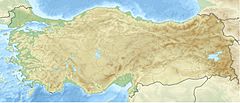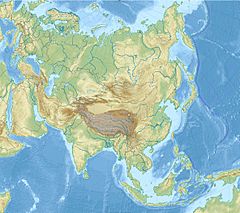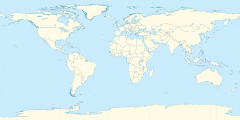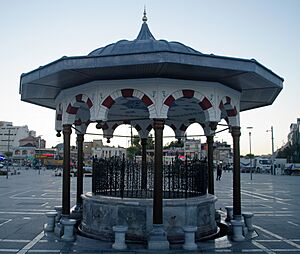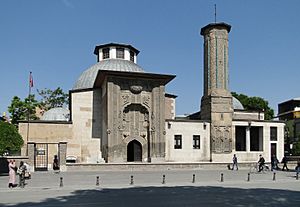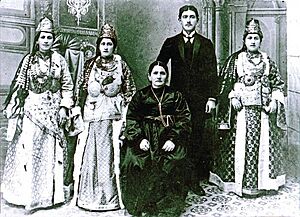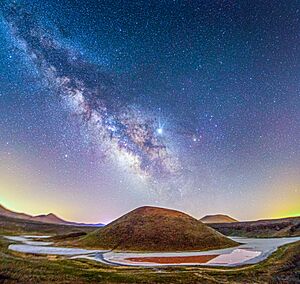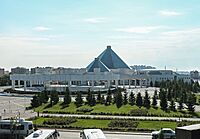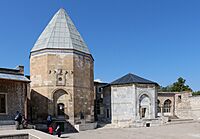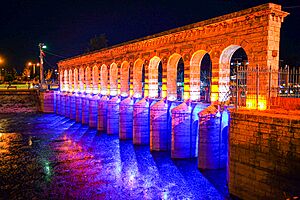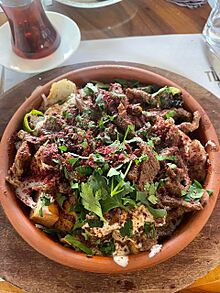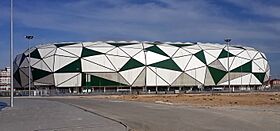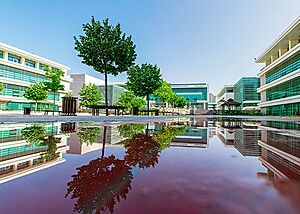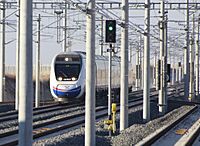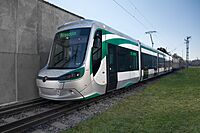Konya facts for kids
Quick facts for kids
Konya
|
||
|---|---|---|
|
Big City Area
|
||
|
Clockwise from top: Konya city view; Selimiye Mosque; Aziziye Mosque; Konya Kültürpark; and Mevlana Museum
|
||
|
||
| Country | ||
| Region | Central Anatolia | |
| Province | Konya | |
| Area | ||
| • Big City Area | 38,873 km2 (15,009 sq mi) | |
| • Urban | 6,600 km2 (2,500 sq mi) | |
| • Metro | 6,600 km2 (2,500 sq mi) | |
| Elevation | 1,016 m (3,333 ft) | |
| Population
(2024 official number of TÜIK)
|
||
| • Big City Area | 2,320,241 | |
| • Density | 59.6877/km2 (154.5905/sq mi) | |
| • Urban | 1,390,051 | |
| • Urban density | 210.6/km2 (545/sq mi) | |
| • Metro | 1,390,051 | |
| • Metro density | 210.6/km2 (545/sq mi) | |
| GDP | ||
| • Metropolitan municipality | TRY 149.229 billion US$ 16.616 billion (2021) |
|
| • Per capita | TRY 65,928 US$ 7,341 (2021) |
|
| Time zone | UTC+3 (TRT) | |
| Postal code |
42XXX
|
|
| Area code(s) | (+90) 332 | |
| Licence plate | 42 | |
Konya is a big city in central Turkey. It sits on the edge of the Central Anatolian Plateau. Konya is the main city of Konya Province. Long ago, it was known as Iconium. In the past, it was also called Konia or Koniah. In the Middle Ages, Konya was the capital of the Seljuk Turks' Sultanate of Rum. From here, the sultans ruled over a large area of Turkey.
As of 2023, over 2.3 million people live in Konya. This makes it the sixth largest city in Turkey. It is also the second largest city in the Central Anatolia Region, after Ankara. You can reach Konya by fast train (YHT) from Istanbul, Ankara, and Karaman. The local airport (Konya Havalimanı, KYA) has many flights from Istanbul. There are also a few flights each week to and from İzmir.
Contents
What's in a Name?
People think the name Konya comes from an old word, Ikkuwaniya. This word was used by the Hittite people in the Late Bronze Age. It is believed to be from the Luwian language. In ancient Greek and medieval times, the city was called Ikónion. In Latin, it was called Iconium.
There's a fun story about the name Ikónion. It's said to come from the Greek word for "image" (eikōn). This story tells of the hero Perseus. He used an image of the Gorgon Medusa's head to defeat the people living there. Then, he founded the city.
The Rum Seljuks called Konya Dârülmülk. This means "House of the Kingdom."
A Look Back in Time
Konya's Long History
People have lived in the Konya area since about 3000 BC. Over time, different groups ruled here. These included the Hittites, the Phrygians, the Greeks, the Persians, and the Romans. In the 11th century, the Seljuk Turks took control. They made Konya the capital of their new Sultanate of Rum. Under the Seljuks, Konya became very rich and powerful.
After the Seljuks, the Karamanids ruled Konya. Then, in the 15th century, the Ottoman Empire took over. After the Turkish War of Independence, Konya became part of modern Turkey.
Ancient Times
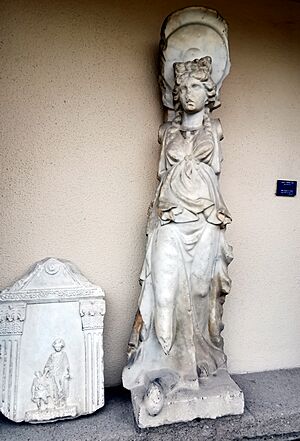
Digs have shown that people lived in this area around 3000 BC. This was during the Late Copper Age.
The Phrygians set up their kingdom in central Anatolia in the 8th century BC. A writer named Xenophon said Iconium was the last city of Phrygia. Around 690 BC, Cimmerian invaders took over the area. Later, it became part of the Persian Empire. This lasted until Darius III was defeated by Alexander the Great in 333 BC. Alexander's empire broke apart after he died. The town then came under the rule of Seleucus I Nicator.
During the Hellenistic period, the kings of Pergamon ruled the town. Attalus III, the last king of Pergamon, had no children to take his place. So, he gave his kingdom to the Roman Republic. When it became part of the Roman Empire, Emperor Claudius changed the city's name to Claudiconium. Later, during Emperor Hadrian's rule, it was known as Colonia Aelia Hadriana.
Saint Paul and Iconium
The Christian Bible, in the Acts of the Apostles, says that Paul and Barnabas preached in Iconium. This was during their first missionary trip around 47–48 AD. They had been treated badly in Antioch before coming here. Their visit to the synagogue in Iconium caused a split. Some Jewish and non-Jewish people believed their message, and some did not. This led to trouble, and people tried to stone the apostles. They then ran away to Lystra and Derbe. This event is also mentioned in the Second Letter to Timothy. It is thought that Timothy might have been with Paul in Iconium, Antioch, and Lystra. Paul and Silas likely visited Konya again around 50 AD. They also probably came back at the start of Paul's third missionary trip a few years later.
An old story, the apocryphal Acts of Paul and Thecla, says that Saint Thecla was born in Iconium. She is said to have saved the city from an attack in 354 AD.
Byzantine Era
Under the Byzantine Empire, Konya became a center for a bishop. Around 370 AD, it was made a main religious center (metropolitan see) for the area called Lycaonia. Saint Amphilochius was the first main bishop. In the 7th century, it became part of the Anatolic Theme. Konya and the nearby Kaballah Fortress were often attacked by Arabs during the Arab–Byzantine wars from the 8th to 10th centuries. Arabs captured it in 723-724. A rebellious general named Andronikos Doukas used the Kaballah fortress as his base in 905–906.
Later, a church for Saint Amphilochius was built inside the Kaballah fortress. It held the saint's tomb. The Turks later thought this was the tomb of Plato, so they renamed the church to Eflâtun Mescidi (Plato's mosque). The monastery of Saint Chariton, another local from Iconium, was a few miles away.
The Seljuk Turks first attacked the area in 1069. But after the Seljuk victory in the Battle of Manzikert in 1071, there was a lot of confusion in Anatolia. A Norman soldier named Roussel de Bailleul started a rebellion in Iconium. The Seljuks finally took over the city in 1084.
Seljuk and Karamanid Times
Iconium became the second capital of the Seljuk Sultanate of Rum after Nicaea fell in 1243. The army of the First Crusade briefly took it over in August 1097. Frederick Barbarossa also took it on May 18, 1190, after the Battle of Iconium (1190). But the Turks took the area back after the Crusaders left.
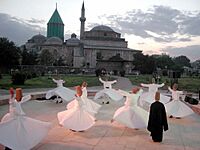
Konya became very rich and powerful in the late 12th century. The Seljuk sultans of Rum also took control of other Turkish areas to their east. This gave them power over almost all of eastern Anatolia. They also gained several port towns on the Mediterranean Sea (like Alanya) and the Black Sea (like Sinop). They even briefly held a place in Sudak, Crimea. This great time lasted until the early 13th century.
Many Persians and Persian-speaking Turks moved to Anatolian cities. They either fled from the Mongol invaders or wanted to find good chances in the new kingdom.
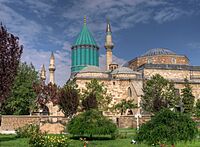
After the Anatolian Seljuk Sultanate fell in 1307, Konya became the capital of the Karamanids. This was a Turkish kingdom that lasted until 1322. Then, the nearby Beylik of Karamanoğlu captured the city. In 1420, the Beylik of Karamanoğlu was taken by the Ottoman Empire. In 1453, Konya became the main city of the Karaman Eyalet province.
Ottoman Empire
Under Ottoman rule, the Sultan's sons (called Şehzade) governed Konya. This started with Şehzade Mustafa and Şehzade Cem, who were sons of Sultan Mehmed II. Later, the future Sultan Selim II also governed here.
From 1483 to 1864, Konya was the main city of the Karaman Eyalet. During a time of changes called the Tanzimat period, it became the center of the larger Vilayet of Konya. This was part of a new system of provinces started in 1864.
In 1832, Mehmed Ali Paşa from Kavala invaded Anatolia. His son, İbrahim Paşa, took over Konya. European countries helped drive him out. After this, Konya became less important. A British traveler, William Hamilton, visited in 1837. He wrote that he saw a place of "destruction and decay."
Konya's textile (cloth) and mining (getting minerals from the ground) industries grew well under the Ottomans.
Turkish Republic
During the Turkish War of Independence (1919–1922), Konya was an important air base. In 1922, the air force's main office was in Konya.
Before 1923, about 4,000 Christian people lived there. They spoke Turkish and Greek. The Greek community had about 2,500 people. They paid for their own church, a school for boys, and a school for girls. In 1923, during a population exchange between Greece and Turkey, the Greeks from the nearby village of Sille had to leave their homes. They moved to Greece as refugees.
Economy
Konya has several industrial areas. It is known as one of the "Anatolian Tigers" because of its fast-growing economy. In 2012, Konya sent its products to 130 countries around the world. Some big Turkish companies, like Bera Holding, have their main offices in Konya.
While farming-related businesses are still important, Konya's economy has changed. It is now a center for making parts for cars and other vehicles. It also makes machinery, farm tools, and cast metal products. Other industries include plastic paints, chemicals, building materials, paper, packaging, processed foods, textiles, and leather.
Turkey's largest solar farm is located about 20 miles east of Konya, near Karapınar.
Geography
Konya is in the middle of Turkey's largest province. It sits on the largest flat land area, called the Konya Plain. It is the seventh most populated city in Turkey.
The city is in the southern part of the Central Anatolia Region. The very southern edge of the province is bordered by the Taurus Mountains.
Climate
Konya has a cold semi-arid climate. This means it's generally dry with hot summers and cold winters.
In summer, daytime temperatures are usually around 30°C (86°F). But summer nights are cool. The hottest temperature ever recorded in Konya was 40.9°C (105.6°F) on August 14, 2023. Winters average -4.2°C (24.4°F). The coldest temperature ever recorded was -26.5°C (-15.7°F) on February 6, 1972. It doesn't rain much in Konya, and most of the rain happens in winter and spring.
| Climate data for Konya (1991–2020, extremes 1929–2023) | |||||||||||||
|---|---|---|---|---|---|---|---|---|---|---|---|---|---|
| Month | Jan | Feb | Mar | Apr | May | Jun | Jul | Aug | Sep | Oct | Nov | Dec | Year |
| Record high °C (°F) | 19.3 (66.7) |
23.8 (74.8) |
28.9 (84.0) |
34.6 (94.3) |
34.4 (93.9) |
36.7 (98.1) |
40.6 (105.1) |
40.9 (105.6) |
38.8 (101.8) |
32.3 (90.1) |
25.4 (77.7) |
21.8 (71.2) |
40.9 (105.6) |
| Mean daily maximum °C (°F) | 4.6 (40.3) |
6.9 (44.4) |
12.5 (54.5) |
17.6 (63.7) |
22.8 (73.0) |
27.4 (81.3) |
31.0 (87.8) |
30.9 (87.6) |
26.7 (80.1) |
20.4 (68.7) |
12.7 (54.9) |
6.3 (43.3) |
18.3 (64.9) |
| Daily mean °C (°F) | −0.3 (31.5) |
1.3 (34.3) |
6.0 (42.8) |
10.9 (51.6) |
15.9 (60.6) |
20.5 (68.9) |
24.1 (75.4) |
24.0 (75.2) |
19.4 (66.9) |
13.4 (56.1) |
6.2 (43.2) |
1.5 (34.7) |
11.9 (53.4) |
| Mean daily minimum °C (°F) | −3.9 (25.0) |
−3.3 (26.1) |
0.2 (32.4) |
4.4 (39.9) |
9.0 (48.2) |
13.6 (56.5) |
17.1 (62.8) |
17.2 (63.0) |
12.3 (54.1) |
7.0 (44.6) |
0.8 (33.4) |
−2.2 (28.0) |
6.0 (42.8) |
| Record low °C (°F) | −28.2 (−18.8) |
−26.5 (−15.7) |
−16.4 (2.5) |
−8.6 (16.5) |
−1.2 (29.8) |
1.8 (35.2) |
6.0 (42.8) |
5.3 (41.5) |
−3.0 (26.6) |
−8.4 (16.9) |
−20.0 (−4.0) |
−26.0 (−14.8) |
−28.2 (−18.8) |
| Average precipitation mm (inches) | 35.9 (1.41) |
23.1 (0.91) |
27.4 (1.08) |
34.2 (1.35) |
38.2 (1.50) |
27.8 (1.09) |
6.5 (0.26) |
6.5 (0.26) |
15.9 (0.63) |
29.7 (1.17) |
34.5 (1.36) |
45.6 (1.80) |
325.3 (12.81) |
| Average precipitation days | 10.53 | 8.97 | 9.80 | 10.83 | 12.47 | 8.10 | 3.00 | 2.63 | 4.40 | 7.27 | 7.13 | 10.10 | 95.2 |
| Average relative humidity (%) | 79.8 | 73.3 | 63.4 | 58.7 | 56.1 | 47.5 | 38.9 | 39.4 | 44.2 | 57.6 | 70.1 | 79.9 | 59.0 |
| Mean monthly sunshine hours | 105.4 | 138.4 | 195.3 | 216.0 | 269.7 | 309.0 | 344.1 | 334.8 | 291.0 | 235.6 | 159.0 | 102.3 | 2,700.6 |
| Mean daily sunshine hours | 3.4 | 4.9 | 6.3 | 7.2 | 8.7 | 10.3 | 11.1 | 10.8 | 9.7 | 7.6 | 5.3 | 3.3 | 7.4 |
| Source 1: Turkish State Meteorological Service | |||||||||||||
| Source 2: NOAA (humidity) | |||||||||||||
Culture
Konya is known for being one of the more traditional and religious cities in Turkey.
Konya was the last home of Rumi (also called Mevlana). His tomb, with its turquoise dome, is the most popular place for tourists to visit in the city. In 1273, Rumi's followers started the Mevlevi Sufi group of Islam. They became famous as the Whirling Dervishes.
Every Saturday, you can watch Whirling Dervish performances (called semas) at the Mevlana Cultural Centre. These are real spiritual events, not just shows for tourists like some in other cities.
Expensive and beautifully designed Konya carpets were sent to Europe during the Renaissance. People would put them on furniture to show how rich and important they were. You can often see them in old oil paintings, showing the wealth of the people who bought the paintings.
Cool Places to Visit
- Mevlâna Museum
- Alaaddin Mosque
- Ince Minaret Medrese—a museum
- Karatay Medrese—a museum
- Sırçalı Medrese
- Sahib-i Ata Mosque complex
- Konya Archaeological and Ethnography Museum
- Koyunoğlu Museum
- Atatürk House Museum
- Mevlana Cultural Centre
- Mevlana Festival
- Selimiye Mosque
- Aziziye Mosque
- Konya Science Centre
- Konya Tropical Butterfly Garden
- Meram, a suburb with popular places for picnics by the water
- Sille, about 8 km (5 miles) northwest of Mevlana Museum: an old village with mosques, churches, cave churches, and ancient tombs
- Çatalhöyük
Delicious Food
One of Konya's most famous dishes is etli ekmek. It's made with slices of lamb served on soft white bread. Konya is also known for very long pides (Turkish pizzas) that are meant to be shared. Another traditional dish is tirit, a rice dish with meat and different vegetables.
Konya is also famous for its sweets. These include cezerye, an old Turkish sweet made from carrots. There's also pişmaniye, which is a bit like cotton candy.
Sports
The city's football (soccer) team, Konyaspor, plays in the Turkish Professional Football League. On May 31, 2017, they won their first national trophy. They beat İstanbul Başakşehir in a penalty shootout to win the Türkiye Kupası. They won again on August 6, 2017, defeating Beşiktaş to win the Türkiye Süper Kupası.
The Konya Metropolitan Stadium (Konya Büyükşehir Stadyumu) is in the Selçuklu area. It can hold up to 42,000 fans.
Konya also hosted the 2022 Islamic Solidarity Games in August 2022.
Education
Selçuk University was founded in 1975. In the 2008–2009 school year, it had the most students (76,080) of any public university in Turkey. The other public university, Necmettin Erbakan University, was started in Konya in 2010.
Private colleges in Konya include KTO Karatay University.
Konya is also home to the Anatolian Eagle Tactical Training Centre. This center trains air forces from NATO countries and friendly nations.
Getting Around
Buses Between Cities
The main bus station in Konya connects to many places, including Istanbul, Ankara, and İzmir. You can get to the city center from the bus station by tram.
City Public Transport
The Konya Tram system is 41 km (25 miles) long. It has two lines and 41 stations. It opened in 1992 and was made bigger in 1996 and 2015. The Konya Tram uses Škoda 28 T vehicles.
Work started on building a Konya Metro (subway) in 2020. It is expected to be finished in 2024 and will have 22 stations.
Konya also has a large network of city buses.
Trains
Konya is connected to Ankara, Eskişehir, Istanbul, and Karaman by high-speed train services. These are run by the Turkish State Railways.
Airport and Airbase
Konya Airport (KYA) is a public airport. It is also a military airbase used by NATO. The Third Air Wing of the 1st Air Force Command is based at the Konya Air Base. This wing controls the four Boeing 737 AEW&C Peace Eagle planes of the Turkish Air Force.
Famous People from Konya
- Jalal al-Din Muhammad Rumi, also known as Mawlana or Mevlana. He inspired the Sufi Mevlevi order, famous for the the Whirling Dervishes and his book Masnavi. He died and was buried in Konya in 1273.
- Amphilochius of Iconium, a Christian bishop from the fourth century.
- Prokopios Lazaridis, a Greek Orthodox metropolitan bishop of the Metropolis of Iconium.
- Murat Yıldırım (actor), an actor and TV presenter.
- Hilmi Şenalp (born 1957), an architect.
Sister Cities
Konya has "sister city" relationships with these cities:
See also
 In Spanish: Konya para niños
In Spanish: Konya para niños








